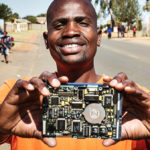 This guest post comes from Pauline Vogl, the lead for environmental employee engagement on the sustainability team in Corporate Affairs. She is a dynamic connector, recognized by leaders as a go-to program manager to solve unique challenges across the business.
This guest post comes from Pauline Vogl, the lead for environmental employee engagement on the sustainability team in Corporate Affairs. She is a dynamic connector, recognized by leaders as a go-to program manager to solve unique challenges across the business.
To mark Earth Day’s 50th anniversary this year, we had planned a very special SustainX, Cisco’s annual sustainability speaker series. We hoped to go live from our Research Triangle Park campus to unveil the newly installed beehives at that location. Then everything changed. So, we did what everyone else is doing, we went virtual! Thanks to Cisco’s Webex technology and our talented internal TV broadcasting team, CiscoTV, we brought “Sustainability at Cisco” to our employees’ homes from our employees’ homes.
We heard from Cisco’s global environmental sustainability lead, Darrel Stickler, who explained why it is so important we find solutions to Cisco’s largest environmental impact: the energy consumption of our products.
Cisco fellow Rakesh Chopra inspired us by describing the massive reduction in environmental impact caused by Cisco’s game-changing Silicon One chip, which is installed in the Cisco Series 8000 routers.
We didn’t just limit ourselves to internal speakers. Our keynote speaker, Paul Hawken, world-renowned environmentalist and author, shared solutions to move beyond slowing global warming to actually reversing it.
To set the stage, Paul described the difference between global warming and climate change. He mentioned people use antagonistic language when referring to climate change, like “fighting,” “combating” and “attacking” climate change. He explained that climate change isn’t the problem. The climate is doing its job based on the inputs it is receiving. Global warming is the problem. Average temperatures are simply increasing and that is something we can do something about.
Paul described three general things we can do to address global warming:
- Avoid and reduce the amount of energy we use and use renewable alternative sources of energy where possible
- Cue the flashing red lights. Protect our biosphere – our forests, oceans, wetlands, soil, insects, animals, air – because without it, Earth becomes a lifeless planet.
- Bring carbon back home! Accelerate natural photosynthesis to bring the carbon dioxide levels back down.
His argument was clear: Carbon can be drawn down! He explained that there are hundreds of ways to pull excess greenhouse gasses from the atmosphere to reduce global warming. Several years ago, over 200 scientists, scholars, and graduate students came together to map, measure and model the 100 most substantive solutions for reversing global warming. Surprisingly, nobody had done that before. That was the beginning of Project Drawdown. Today, these possibilities, these solutions are taught in all levels of school, from elementary through university. And, Drawdown Labs work to advance the next level of business leadership on climate solutions.
You might wonder, how did Paul fit all his solutions into one 30-minute talk? It wasn’t easy, but he listed the top ten carbon drawdown solutions:
- Refrigeration Management
- Wind Turbines (onshore and offshore)
- Reduced Food Waste
- Plant-Rich Diet
- Tropical Forest Protection
- Educating Girls
- Family Planning
- Solar Farms
- Silvopasture
- Rooftop Solar
Incidentally, these solutions also address poverty, education, job security, well-being – they don’t just protect our environment alone. You can find these and the other 90 solutions on the Project Drawdown website or in Paul’s book, Drawdown.
We need smart, driven people to work towards these solutions and to create new ones. Who better to ask than a company made of innovators? In his presentation, Paul challenged Cisco employees to think deeply about reversing global warming and come up with their own solutions. In essence, he urged Cisco to move beyond reasonable goals to reach carbon neutrality to set unreasonable goals to achieve carbon drawdown.
Cisconians can submit those ideas to Cisco’s internal Innovate Everywhere Challenge. Cisco strives to foster big thinking beyond our walls as well. That’s why we invite all innovators to enter our Global Problem Solvers challenge, and compete to win $350,000 in grants to help make your idea a reality. Applications for this annual program will reopen in the fall.



CONNECT WITH US